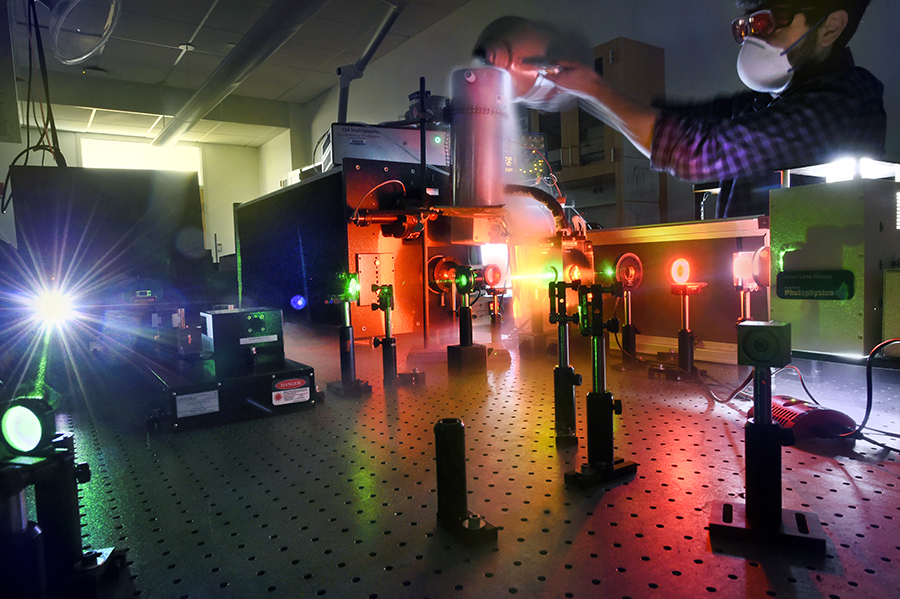The University of North Carolina at Chapel Hill will lead a $40 million Department of Energy project to research solar energy production.
The grant has been given to the North Carolina-based Center for Hybrid Approaches in Solar Energy to Liquid Fuels, otherwise known as CHASE, to accelerate fundamental research of the production of fuels from sunlight.
Dr. Jillian Dempsey is an inorganic chemist, an assistant professor in the Department of Chemistry at UNC and the deputy director of CHASE – the network of investigators from six universities who earned the $40-million-dollar research grant. With more than 35 investigators partnered in the CHASE effort, UNC-Chapel Hill leads the group.
Their goal is to figure out how to harness solar energy as a clean and renewable energy resource. Dempsey said this means developing an artificial photosynthesis system.
“So to harness solar energy to its full capacity and make it part of our full global energy economy, we need to think about energy storage,” Dempsey said. “When thinking about that, CHASE has turned to the process of photosynthesis – which is what green plants do when they take sunlight, water and carbon dioxide and generate oxygen into carbohydrates or sugars, which are the plants chemical fuel.”
Right now, there are solar panels that take solar energy and convert it to electricity – but Dempsey said the main issue with solar panels is that when the sun sets every night, they are not actively generating electricity.
Dempsey said just as our current energy infrastructure is based on fuels like gasoline, oil and coal – which are stored forms of chemical energy – CHASE would be producing liquid fuels with their artificial photosynthesis systems.
“So what we’re trying to do is to take feedstock like water and carbon dioxide – which are energy-poor molecules – and use the energy from the sun to rearrange the atoms and the chemical bonds in those small molecules to create high-energy density molecules or fuels,” Dempsey said.
Simply put, Dempsey said this an opportunity to store the energy of the sun in a fuel.
However, there are significant scientific barriers to the development of such a system – requiring new discoveries and fundamental breakthroughs.
“The biggest barrier is to couple the light harvesting component of photosynthesis with the chemical fuel production component,” Dempsey said. “Both of those individually will be challenging research targets, but finding a way to integrate the science of light harvesting and solar energy capture with the fuel production chemistry is really our major challenge.”
Despite these fundamental challenges that the science community is currently facing in terms of transferring the natural process of photosynthesis into a man-made system, Dempsey and her team at CHASE hope to overcome these hurdles in the next five years.
After that, she said it’s about transferring these scientific advances into physical technology systems, which will most likely take 15 to 20 years to fully commercialize and implement into our everyday lives.
According to Dempsey, there’s no time to waste.
“I think what I’m most excited about is the opportunity for us to start stepping back our use of fossil fuels now that we’ll be able to provide solar fuels,” Dempsey said. “So we’ll be able to use solar fuels in a way that we currently use fossil fuels without having the environmental impact that fossil fuels have. This will really help us find the solution for our entire planet.”
Lead photo courtesy of UNC-Chapel Hill.
Chapelboro.com does not charge subscription fees. You can support local journalism and our mission to serve the community. Contribute today – every single dollar matters.
Related Stories
‹

North Carolina Gov. Cooper Vetoes Two More Bills, but Budget Still on Track To Become Law TuesdayWritten by GARY D. ROBERTSON North Carolina Gov. Roy Cooper vetoed on Monday both an energy bill and the legislature’s annual regulatory reform measure, while allowing legislation directing more state government oversight of high school athletics to become law. The measures were among those the General Assembly approved last month before it left Raleigh for […]

Remember the State's Carbon Plan? Here's How Duke Energy Plans to Address ItAbout a month ago, the state passed a plan that requires public utility companies to change how they use fossil fuels.

NC Governor Has Little Wiggle Room With Legislature in 2023Written by GARY D. ROBERTSON North Carolina Democratic Gov. Roy Cooper described on Wednesday jobs announcements, an emerging clean energy sector and his ability to block “culture-war, business-killing” laws on social issues from the General Assembly among his administration’s accomplishments during 2022. There could be little room for error in his dealings with the legislature […]

Duke Energy, Climate Advocacy Groups Present Differing Carbon Plans to NCDuke Energy has a plan for reaching North Carolina's carbon emissions goals – but some environmental groups are suggesting different methods.
![]()
Kevin Lindley - Chatham County Environmental Quality DirectorChatham County Environmental Quality Director Kevin Lindley spoke with 97.9 The Hill's Andrew Stuckey on Tuesday, August 2. He discussed the new Solarize the Triangle initiative that incentivizes residents and business to install solar systems.
![]()
Commerce Inquiry Imperils Solar Industry, Advocates SayWritten by MATTHEW DALY In a decision that could dramatically undercut President Joe Biden’s ambitious climate goals, the Commerce Department said Monday it is investigating whether imports of solar panels from Southeast Asia are circumventing anti-dumping rules that limit imports from China. Clean energy leaders said the investigation — which could result in retroactive tariffs […]

Climate Change: North Carolina Gov Signs Major Energy LawWritten by GARY D. ROBERTSON Democratic Gov. Roy Cooper of North Carolina signed a milestone energy bill into law Wednesday that aims to sharply reduce greenhouse gas emissions from the state’s power plants by 2030, celebrating the legislative accomplishment with Republican lawmakers. In a ceremony with legislators from both parties, Cooper enacted a consensus measure that now […]
![]()
Textile, Environment Advocates Speak Against NC Energy BillWritten by GARY D. ROBERTSON North Carolina textile executives joined advocates for the environment and the poor on Monday to urge state legislators to reject a major energy bill pushed by House Republicans. The coalition held a news conference to criticize the wide-ranging proposal, which would order an early retirement of several coal-fired plants operated […]

Sponsors Defend NC Energy Bill Goals While Cooper Pans ItWritten by GARY D. ROBERTSON Negotiators of a wide-ranging North Carolina energy bill to retire Duke Energy coal-fired electricity plants, expand solar power production and keep nuclear power defended their goals on Thursday despite current opposition to the measure from interest groups and Gov. Roy Cooper. The bill’s contents, revealed this week after months of input […]

UNC Partnership, Researchers Working to Convert Sunlight Into Liquid FuelThe University of North Carolina at Chapel Hill will lead a $40 million Department of Energy project to research solar energy production. The grant has been given to the North Carolina-based Center for Hybrid Approaches in Solar Energy to Liquid Fuels, otherwise known as CHASE, to accelerate fundamental research of the production of fuels from […]
›







